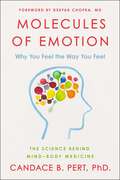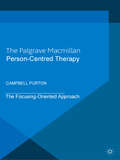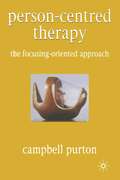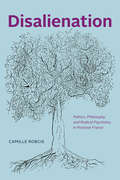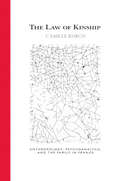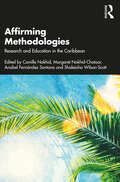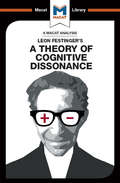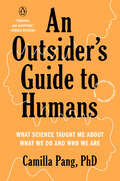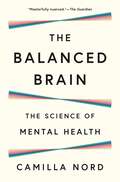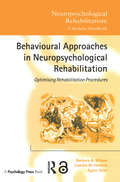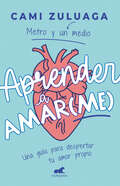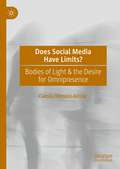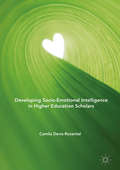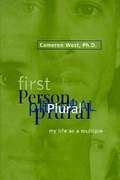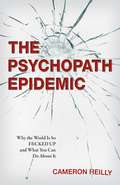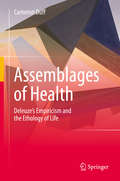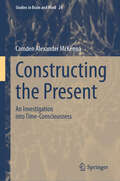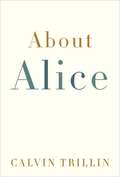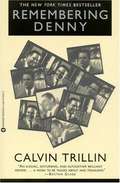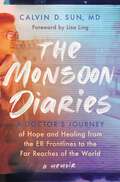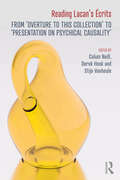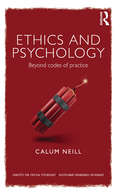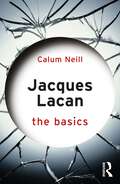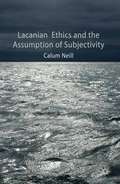- Table View
- List View
Molecules of Emotion: The Science Behind Mind-Body Medicine
by Candace B. PertThe bestselling and revolutionary book that serves as a &“landmark in our understanding of the mind-body connection&” (Deepak Chopra, MD).Why do we feel the way we feel? How do our thoughts and emotions affect our health? In her groundbreaking book Molecules of Emotion, Candace Pert—an extraordinary neuroscientist who played a pivotal role in the discovery of the opiate receptor—provides startling and decisive answers to these and other challenging questions that scientists and philosophers have pondered for centuries. Pert&’s pioneering research on how the chemicals inside our bodies form a dynamic information network, linking mind and body, is not only provocative, it is revolutionary. By establishing the biomolecular basis for our emotions and explaining these scientific developments in a clear and accessible way, Pert empowers us to understand ourselves, our feelings, and the connection between our minds and our bodies—or bodyminds—in ways we could never possibly have imagined before. From explaining the scientific basis of popular wisdom about phenomena such as "gut feelings" to making comprehensible recent breakthroughs in cancer and AIDS research, Pert provides us with an intellectual adventure of the highest order. Molecules of Emotion is a landmark work, full of insight and wisdom and possessing that rare power to change the way we see the world and ourselves.
The Neural Basis Of Thought: The Diaries Of Escher, Bodmer, May And De Gallois 1814-18
by Campion, George G & Elliot Smith, GraftonFirst Published in 1999. Routledge is an imprint of Taylor & Francis, an informa company.
Person-Centred Therapy: The Focusing-Oriented Approach
by Campbell PurtonSince its beginnings in the 1950s, the person-centred approach to therapy has developed in many ways. In this important new text, Campbell Purton introduces the 'focusing' approach of Eugene Gendlin. The book discussed Gendlin's theoretical innovations and their implications for clinical practice. It throws light on the relationship between the various schools of therapy, and on the relationship between therapy and such areas as ethics and spirituality. It will be essential reading for students and practioners of person-centred therapy.
Person-Centred Therapy: The Focusing-Oriented Approach
by Campbell PurtonSince its beginnings in the 1950s, the person-centred approach to therapy has developed in many ways. In this important new text, Campbell Purton introduces the 'focusing' approach of Eugene Gendlin. The book discussed Gendlin's theoretical innovations and their implications for clinical practice. It throws light on the relationship between the various schools of therapy, and on the relationship between therapy and such areas as ethics and spirituality. It will be essential reading for students and practioners of person-centred therapy.
Disalienation: Politics, Philosophy, and Radical Psychiatry in Postwar France (Chicago Studies In Practices Of Meaning Ser.)
by Camille RobcisFrom 1940 to 1945, forty thousand patients died in French psychiatric hospitals. The Vichy regime’s “soft extermination” let patients die of cold, starvation, or lack of care. But in Saint-Alban-sur-Limagnole, a small village in central France, one psychiatric hospital attempted to resist. Hoarding food with the help of the local population, the staff not only worked to keep patients alive but began to rethink the practical and theoretical bases of psychiatric care. The movement that began at Saint-Alban came to be known as institutional psychotherapy and would go on to have a profound influence on postwar French thought. In Disalienation, Camille Robcis grapples with the historical, intellectual, and psychiatric meaning of the ethics articulated at Saint-Alban by exploring the movement’s key thinkers, including François Tosquelles, Frantz Fanon, Félix Guattari, and Michel Foucault. Anchored in the history of one hospital, Robcis's study draws on a wide geographic context—revolutionary Spain, occupied France, colonial Algeria, and beyond—and charts the movement's place within a broad political-economic landscape, from fascism to Stalinism to postwar capitalism.
The Law Of Kinship
by Camille RobcisIn France as elsewhere in recent years, legislative debates over single-parent households, same-sex unions, new reproductive technologies, transsexuality, and other challenges to long-held assumptions about the structure of family and kinship relations have been deeply divisive. What strikes many as uniquely French, however, is the extent to which many of these discussions-whether in legislative chambers, courtrooms, or the mass media-have been conducted in the frequently abstract vocabularies of anthropology and psychoanalysis. In this highly original book, Camille Robcis seeks to explain why and how academic discourses on kinship have intersected and overlapped with political debates on the family-and on the nature of French republicanism itself. She focuses on the theories of Claude Levi-Strauss and Jacques Lacan, both of whom highlighted the interdependence of the sexual and the social by positing a direct correlation between kinship and socialization. Robcis traces how their ideas gained recognition not only from French social scientists but also from legislators and politicians who relied on some of the most obscure and difficult concepts of structuralism to enact a series of laws concerning the family. Levi-Strauss and Lacan constructed the heterosexual family as a universal trope for social and psychic integration, and this understanding of the family at the root of intersubjectivity coincided with the role that the family has played in modern French law and public policy. The Law of Kinship contributes to larger conversations about the particularities of French political culture, the nature of sexual difference, and the problem of reading and interpretation in intellectual history.
Affirming Methodologies: Research and Education in the Caribbean
by Camille NakhidAffirming Methodologies: Research and Education in the Caribbean centres local and indigenous ways of knowing in research and education praxis in the Caribbean. The research methodologies and pedagogies are presented in this book within an Affirming Methodologies framework. They bring forward localized epistemologies whereby Caribbean ways of being and knowing are affirmed, and the expected western hierarchies between researcher and researched are removed. The chapters present approaches to knowledge construction and knowledge sharing based on practices, lived experiences, traditions, language patterns, and rituals of Caribbean communities. The importance of an Affirming Methodologies approach is demonstrated, and the characteristics of culturally affirming research methodologies and pedagogies in diverse environments including Cuba, Trinidad and Tobago, Jamaica and the Caribbean diaspora in Aotearoa New Zealand and Canada are explored and presented. Grounded on an understanding of the authors’ Caribbean positionality, ontological distinctions within the Caribbean research context are considered. This book moves forward from a decolonizing methodology approach, and, as such, the chapters are written, not in opposition to, or tested against Eurocentric approaches to research, but deeply rooted in a Caribbean ethos. This book will engage researchers (both qualitative and quantitative), postgraduate students, academics, practitioners, policymakers, community workers, and lay persons who seek to employ culturally relevant local and indigenous research approaches in their work. Each chapter offers practical suggestions on the 'how' of research practice, making them accessible, relevant, and flexible for novice and seasoned researchers alike.
A Theory of Cognitive Dissonance
by Camille Morvan Alexander O’ConnorLeon Festinger’s 1957 A Theory of Cognitive Dissonance is a key text in the history of psychology – one that made its author one of the most influential social psychologists of his time. It is also a prime example of how creative thinking and problem solving skills can come together to produce work that changes the way people look at questions for good. Strong creative thinkers are able to look at things from a new perspective, often to the point of challenging the very frames in which those around them see things. Festinger was such a creative thinker, leading what came to be known as the “cognitive revolution” in social psychology. When Festinger was carrying out his research, the dominant school of thought – behaviorism – focused on outward behaviors and their effects. Festinger, however, turned his attention elsewhere, looking at “cognition:” the mental processes behind behaviors. In the case of “cognitive dissonance”, for example, he hypothesized that apparently incomprehensible or illogical behaviors might be caused by a cognitive drive away from dissonance, or internal contradiction. This perspective, however, raised a problem: how to examine and test out cognitive processes. Festinger’s book records the results of the psychological experiments he designed to solve that problem. The results helped prove the existence for what is now a fundamental theory in social psychology.
An Outsider's Guide to Humans: What Science Taught Me About What We Do and Who We Are
by Camilla PangWINNER OF THE ROYAL SOCIETY SCIENCE BOOK PRIZEAn instruction manual for life, love, and relationships by a brilliant young scientist whose Asperger's syndrome allows her--and us--to see ourselves in a different way...and to be better at being humanDiagnosed with Autism Spectrum Disorder at the age of eight, Camilla Pang struggled to understand the world around her. Desperate for a solution, she asked her mother if there was an instruction manual for humans that she could consult. With no blueprint to life, Pang began to create her own, using the language she understands best: science. That lifelong project eventually resulted in An Outsider's Guide to Humans, an original and incisive exploration of human nature and the strangeness of social norms, written from the outside looking in--which is helpful to even the most neurotypical thinker. Camilla Pang uses a set of scientific principles to examine life's everyday interactions:- How machine learning can help us sift through data and make more rational decisions- How proteins form strong bonds, and what they teach us about embracing individual differences to form diverse groups- Why understanding thermodynamics is the key to seeking balance over seeking perfection- How prisms refracting light can keep us from getting overwhelmed by our fears and anxieties, breaking them into manageable and separate "wavelengths"Pang's unique perspective of the world tells us so much about ourselves--who we are and why we do the things we do--and is a fascinating guide to living a happier and more connected life.
The Balanced Brain: The Science of Mental Health
by Camilla NordHow we can use what we&’ve learned about the brain to improve our mental healthThere are many routes to mental well-being. In this groundbreaking book, neuroscientist Camilla Nord offers a fascinating tour of the scientific developments that are revolutionising the way we think about mental health, showing why and how events—and treatments—can affect people in such different ways.In The Balanced Brain, Nord explains how our brain constructs our sense of mental health—actively striving to maintain balance in response to our changing circumstances. While a mentally healthy brain deals well with life&’s turbulence, poor mental health results when the brain struggles with disruption. But just what is the brain trying to balance? Nord describes the foundations of mental health in the brain—from the neurobiology of pleasure, pain and desire to the role of mood-mediating chemicals like dopamine, serotonin and opioids. She then pivots to interventions, revealing how antidepressants, placebos and even recreational drugs work; how psychotherapy changes brain chemistry; and how the brain and body interact to make us feel physically (as well as mentally) healthy. Along the way, Nord explains how the seemingly small things we use to lift our moods—a piece of chocolate, a walk, a chat with a friend—work on the same pathways in our brains as the latest treatments for mental health disorders.Understanding the cause of poor mental health is one of the crucial questions of our time. But the answer is unique to each of us, and it requires finding what helps our brains rebalance and thrive. With so many factors at play, there are more possibilities for recovery and resilience than we might think.
Behavioural Approaches in Neuropsychological Rehabilitation: Optimising Rehabilitation Procedures (Neuropsychological Rehabilitation: A Modular Handbook)
by Barbara A. Wilson Camilla M. Herbert Agnes ShielThe potential of behavioural approaches for improving the lives of people with acquired brain injury is immense. Here that potential is laid out and explored with a thoroughgoing regard for clinical practice and the theoretical frameworks that underpin that practice. This book will prove an invaluable resource for clinical psychologists and the whole range of therapists working with patients suffering from acquired brain damage.
Aprender a amar(me)
by Camila Zuluaga"El amor propio nos enseña que el dolor no es una opción" CAMI ZULUAGA, influenciadora colombiana, tuvo un episodio depresivo muy fuerte y descubrió que también sufre de codependencia, un trastorno que la hace tener relaciones tóxicas. En este inspirador libro nos cuenta su proceso de rehabilitación, y con ejercicios, consejos y actividades, nos comparte las herramientas que la ayudaron a salir adelante. Aprender a amar(me) nos va a enseñar a tener relaciones amorosas y saludables, empezando por la más importante: la que tenemos con nosotros mismos
Does Social Media Have Limits?: Bodies of Light & the Desire for Omnipresence
by Camila Mozzini-AlisterThis book is a vibrant investigation on a deeply human subconscious desire: the desire for omnipresence, or in a nutshell, the desire to be here, there, and everywhere at the same time. After all, why is it not enough just to be in the offline ordinariness of the here and now? To answer this question, Camila Mozzini-Alister does the crossing of two seemingly distant universes: mediation and meditation. Throughout a vigorous archaeology of the relationship between screen and mind allied with an engaging first-person narrative, the author raises awareness of the risks of becoming addicted to social media and obsessed by meditation. This brings forth a vital question: what are the limits for the desire to be more than a body?
Developing Socio-Emotional Intelligence in Higher Education Scholars
by Camila Devis-RozentalThis book explores the impact of socio-emotional intelligence on wellbeing in higher education. Stemming from years of investigation and educational expertise with trainee teachers and academics, the book identifies ways in which socio-emotional intelligence can be developed in university environments. The author begins by analysing the concept of socio-emotional intelligence and its development, before confronting distinctive areas for improvement within the context of teaching and learning in higher education. The book explores the importance of understanding and labelling emotions, and how opportunities for self-reflection arise through an environment that meets practical needs. The author contends that support from other scholars is vital to the development of socio-emotional intelligence. The book concludes with a set of practical suggestions for promoting personal development. It will be a valuable resourse for anyone working in higher education who is interested in improving their own wellbeing and that of those around them.
First Person Plural: My Life As a Multiple
by Cameron West"What the hell's happening to me? I feel possessed. I'm talking gibberish in the mirror and somebody else's voice is coming out of my mouth!" Cameron West was in his thirties, a successful businessman, happily married and the father of a young son, when he spoke these words. The "voice" belonged to Davy. the first of twenty-four distinct personalities to emerge over a period of several months and recount memories of horrific abuse that had been kept secret from West all his life. There was eight-year-old Clay, tense and stuttering; twelve-year-old Dusty, gentle and kind, but disappointed to find herself in the body of a middle-aged man: Bart, lightheaded and supportive; Leif, with his incredible focus and drive, who sometimes overwhelmed West with his demands, and nineteen other personalities-all with distinct characteristics, mannerisms, and memories. In first Person Plural, West offers a poignant account of his efforts to understand the workings of his fragmented mind and to heal his damaged spirit as he desperately hangs on to the slender thread that connects him to his wife, Rikki, his son, Kyle, and some semblance of a regular life. In addition to a spellbinding story. West provides rare and unprecedented insight into the fascinating workings of the mind of a multiple and his alters' coexistence with one another and with those "outside." heart wrenching. humorous, and ultimately hopeful. First Person Plural is a story that will make you stand in awe of the power of the mind to protect itself and cheer for West as he struggles to gain control of his life.
The Psychopath Epidemic: Why the World Is So F*cked Up and What You Can Do About It
by Cameron ReillySimilar to the bestselling Sociopath Next Door comes a unique look at the psychopaths among us and how our society--from businesses and governments to religions--encourages and rewards psychopathic behavior, and what average citizens can do to survive and thrive when we must live with, learn from, or be led by sociopaths.Psychiatrists estimate that 1 percent of the adult population are psychopaths. That's about two million Americans. And they are our bosses, our politicians, our priests, and our neighbors. And they are running our economy and our lives. Every day in the news we hear about people in positions of power doing deplorable things--in business, politics, and government, from sexual harassment to polluting the environment to covering up crimes. And it's no wonder considering a small percentage of people wield a large amount of power, and that these very same people fit the definition of a "psychopath." A highly engaging and gripping read, Cameron Reilly's book adds to our growing understanding of sociopaths with a detailed analysis of how our society encourages and rewards psychopathic tendencies, and how, because of this, psychopaths the world over have risen to power. Using historical references to pop culture examples, Reilly offers a field guide to psychopaths--how to spot them and how to outmaneuver them so you can keep your sanity intact. This is the first-of-its-kind book to examine the shocking evidence and then suggest practical solutions for saving us all.
Assemblages of Health: Deleuze's Empiricism and the Ethology of Life
by Cameron DuffThis book presents a review of Deleuze's key methods and concepts in the course of exploring how these methods may be applied in contemporary studies of health and illness. Taken from a Deleuzian perspective, health and wellbeing will be characterized as a discontinuous process of affective and relational transitions. The book argues that health, conceived in terms of the quality of life, is advanced or facilitated in the provision of new affective sensitivities and new relational capacities. Following an assessment of Deleuze's key ideas, the book will offer a series of case studies designed to illustrate how Deleuze's ideas can be applied to select health problems. This analysis draws out the specific advantages of a Deleuzian approach to public health research, establishing grounds for more widespread engagement with Deleuze's ideas across the health and social sciences.
Constructing the Present: An Investigation into Time-Consciousness (Studies in Brain and Mind #24)
by Camden Alexander McKennaConstructing the Present: An Investigation into Time-Consciousness investigates what time is like for us as subjects and answers the question of how our experiential present comes to be. While addressing a variety of outstanding debates in the field, the book proposes that our temporal phenomenology is best understood as transcending traditional forms of analysis. The book ultimately concludes that time is not something we experience, but rather the way we construct our experience of the world. In the spirit of William James, McKenna suggests that the present occupies a window of time known as the &“specious present.&” McKenna claims that the duration of this subjective window is determined by the real temporal properties of experience, but also that experiential events are, as Edmund Husserl believed, temporally directed to varying degrees and in nested fashion in a way that affects their particular qualitative character. This specific proposal is called ERA: the Extensional-Retentional Analysis of temporal phenomenology. Besides doing justice to our temporal phenomenology, McKenna&’s overall position aligns with contemporary predictive approaches to the cognitive architecture of the mind. This exciting new way of thinking sees the brain as a predictive engine whose ongoing activities construct our rich subjective experiences. Taking inspiration from this movement, Constructing the Present introduces a complementary position called Temporality as Iterative Expectation Revision (or TIER). According to TIER, temporal phenomenology results from predictive activities of the brain occurring throughout an integrated multilevel cognitive processing hierarchy. Such a system is sensitive to the ongoing flux of environmental stimuli while retaining prior expectations and constantly updating our experiences probabilistically to ensure survival. The actual activity of this ongoing process, rather than its content, gives rise to the felt present, which is continuously constructed anew. Constructing the Present: An Investigation into Time-Consciousness functions as a scholarly defense of a provocative, plausible, and cohesive set of theses, while also confronting numerous adjacent philosophical issues along the way. By approaching the subject from the standpoint of empirically informed philosophy of mind, the present work fills a significant gap in the literature. The book should appeal especially to philosophically inclined researchers and students interested in cognitive science, psychology, and neuroscience, as well as philosophy of mind.
About Alice
by Calvin TrillinIn Calvin Trillin's antic tales of family life, she was portrayed as the wife who had "a weird predilection for limiting our family to three meals a day" and the mother who thought that if you didn't go to every performance of your child's school play, "the county would come and take the child." Now, five years after her death, her husband offers this loving portrait of Alice Trillin off the page-his loving portrait of Alice Trillin off the page-an educator who was equally at home teaching at a university or a drug treatment center, a gifted writer, a stunningly beautiful and thoroughly engaged woman who, in the words of a friend, "managed to navigate the tricky waters between living a life you could be proud of and still delighting in the many things there are to take pleasure in."Though it deals with devastating loss, About Alice is also a love story, chronicling a romance that began at a Manhattan party when Calvin Trillin desperately tried to impress a young woman who "seemed to glow.""You have never again been as funny as you were that night," Alice would say, twenty or thirty years later."You mean I peaked in December of 1963?""I'm afraid so."But he never quit trying to impress her. In his writing, she was sometimes his subject and always his muse. The dedication of the first book he published after her death read, "I wrote this for Alice. Actually, I wrote everything for Alice."In that spirit, Calvin Trillin has, with About Alice, created a gift to the wife he adored and to his readers.From the Hardcover edition.
Remembering Denny
by Calvin TrillinAuthor examines the life of Denny, the emblematic college hero of 1957 America. From Denny's Yale graduation and turn as a Rhodes Scholar to his eventual suicide as a middle-aged, mid-level academic, author charts the mysterious course of a life.
The Monsoon Diaries: A Doctor’s Journey of Hope and Healing from the ER Frontlines to the Far Reaches of the World
by Calvin D. Sun"There are heroes among us, and Dr. Calvin Sun is one of them. Read this book." -Lisa Ling, journalistThe Monsoon Diaries is the firsthand account of Dr. Calvin Sun, an emergency room doctor who worked tirelessly on the front lines in multiple hospitals during the COVID-19 pandemic.Drawing upon the lessons he learned from his adventures traveling to more than 190 countries in ten years, as well as from the grief he experienced as a teen when his father died, Dr. Sun shares his journey, from growing up as a young Asian American in New York to his calling first to medical school and then to the open road.He believes that the fight for a better world creates meaning when all feels meaningless, and he hopes that telling his story will help readers reframe this tragic moment in our lifetimes into possibility, with the goal of building a more empathetic society.
Reading Lacan’s Écrits: From ‘Overture to this Collection’ to ‘Presentation on Psychical Causality’
by Calum Neill, Derek Hook and Stijn VanheuleReading Lacan's Écrits is the first extensive set of commentaries on the complete edition of Lacan's Écrits to be published in English, providing an indispensable companion piece to some of Lacan's best-known but notoriously challenging writings.With the contributions of some of the world's most renowned Lacanian scholars and analysts, Reading Lacan's Écrits encompasses a series of systematic, paragraph-by-paragraph commentaries that not only contextualise, explain and interrogate Lacan's arguments but also afford the reader multiple interpretive routes through the complete edition of Lacan's most labyrinthine of texts. Considering the significance of Écrits as a landmark in the history of psychoanalysis, this far-reaching and accessible guide will sustain and continue to animate critical engagement with one of the most challenging intellectual works of the twentieth century.These volumes act as an essential and incisive reference-text for psychoanalysts and psychoanalytic psychotherapists in training and in practice, as well as philosophers, cultural theorists and literary, social science and humanities researchers. This volume covers the first two sections of the Écrits, providing close readings of the first eight essays.
Ethics and Psychology: Beyond Codes of Practice (Concepts for Critical Psychology)
by Calum NeillThis highly original book explores the idea and potential of psychology in the context of ethical theory, and the idea of ethics in the context of psychology. In so doing, it not only interrogates how we come to understand ethics and notions of right behaviour, but also questions the discipline of psychology and how it functions in the 21st century. Neill turns psychology inside out, controversially suggesting that psychology no longer exists as we know it. He proposes a rebirth of psychology based on an intricate and detailed examination of who we really are, and how we come to structure this idea of ourselves. Taking the idea of ethics seriously, Neill allows us to see psychology in a totally new light, addressing key points, such as: The inadequacy of psychology to address the question of ethics throughout history. Why thinking through the question of ethics necessarily brings us into confrontation with a question of psychology. What we actually do when we do psychology and how, via a serious consideration of ethics we might do this differently and better. Ethics and Psychology presents readers with a new and potentially productive understanding of both ethics and psychology and will appeal to anyone active within and critically engaged with the field.
Jacques Lacan: The Basics (The Basics)
by Calum NeillJacques Lacan: The Basics provides a clear and succinct introduction to the work of Jacques Lacan, one of the key thinkers of the twentieth century. Lacan’s ideas are applied in the study of the humanities, politics, and psychology as well as contemporary media and the arts, but their complexity makes them impenetrable to many. This book is unique in explaining the key concepts and context, from Lacan’s understanding of psychoanalysis to drive and desire, in an accessible way without diluting them beyond meaning. Examples from popular culture are used throughout to emphasise the ideas being discussed and a full glossary and list of resources for further reading encourages additional exploration. This engaging and accessible text is essential reading for all those interested in Lacan and his work, as well as students of psychology, psychoanalysis, literature, politics, cultural studies, film studies, and more.
Lacanian Ethics and the Assumption of Subjectivity
by Calum NeillHowever we conceive of ethics, whether by appeal to an exterior or traditional notion of right and wrong, or by appeal to some form of individual virtue or responsibility, it implies some form of agency. Where there is an ethical act, there must be someone acting ethically. Working from this simple premise, this book argues that the manner in which we conceive that 'someone' is the condition of possibility for our conception of ethics and, consequently, our ethical potential. Against the commonplace conception of the modern individual as self-identical, self-aware and self-governing, theauthor presents a detailed introduction to the Lacanian subject, a conception of the self as anything but self-identical, self-aware and self-governing. The book goes on to show how such a rethinking of the subject necessitates a rethinking of our relation to law, tradition and morality, as well as a rethinking of our understanding of guilt, responsibility and desire. In short, it necessitates a rethinking of ethics. "
